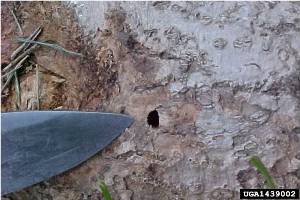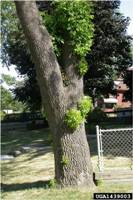Written by: G.K. Douce, C. Evans, and D.J. Moorhead for Forest Encyclopedia Network

Emerald ash borer, Agrilus planipennis, is a newly introduced species (found in 2002) from Asia. Populations have been found in Michigan, Ohio, Illinois, Indiana, Iowa, Maryland, Minnesota, Missouri, New York, Pennsylvania, Virginia, Wisconsin, Ontario, and Quebec (USDA 2011). Larvae feed on phloem and sapwood of ash species (Fraxinus spp.), girdling and killing the trees. In the United States, white ash (F. americana), green ash (F. pennsylvanica), and black ash (F. nigra) have been infested as well as ornamental varieties of ash.
Figure 2. Life stages of the emerald ash borer. (A) (left): An adult emerald ash borer with bronze to green bodies and metallic green wings. (B) (right): Emerald ash borer larva are long, cream colored, and dorso-ventrally flattened. Images courtesy of forestryimages.org.
The emerald ash borer usually has a one-year life cycle. Adults emerge in early summer. The adult beetles usually live for about three weeks, during which time they are very active during warm, sunny days (McCullough et al. 2008). Adults feed upon ash leaves and lay their eggs in bark crevices of ash trees. Once the eggs hatch, larvae bore into the cambium layer and begin making winding S-shaped galleries. The larvae overwinter inside the tree and pupation begins in late spring. The new adults emerge in early summer, leaving a clear-cut, D-shaped exit hole (Wilson and Rebek 2005).
Adults are small, slender beetles (10 to 13 mm in length) (Wilson and Rebek 2005). Adult bodies are green to bronze. The wing covers are noticeably metallic green (Fig. 2a). The larvae are 26 to 32 mm in length, cream colored, and dorsa-ventrally flattened (Fig. 2b).
Typical infestation symptoms include the presence of D-shaped exit holes, vertical splitting of the bark, and epicormal sprouts (Wilson and Rebek 2005). Crown dieback usually occurs after two years of infestation. Trees often die after three to four years of infestation.
Figure 3. Signs that may indicate that a tree is or was infested with emerald ash borer. (A) (left): Adult exit holes have a characteristic D-shape. (B) (right): Epicormal growth, shoots sprouting from the main trunk, is a sign of stress that could be related to emerald ash borer infestations. Photos courtesy of forestryimages.org.
Although ash species do not dominate the southern Appalachians as they do in midwestern and other eastern forests, they still comprise a significant proportion of the forest canopy. Emerald ash borers have the potential to severely reduce the occurrence of ash trees throughout the southern Appalachians, alter the ecosystem, and reduce the biodiversity of the forest canopy. Ash trees are also an important ornamental urban shade tree across most of the northern United States including western states, and emerald ash borer could cause significant damage and costs.
Adapted for eXtension.org by Tom DeGomez, University of Arizona
References Cited:
USDA – Forest Service and Michigan State University. 2011. Emerald Ash Borer. http://www.emeraldashborer.info. [Date accessed: March 11, 2011]
McCullough, D.G., N.F. Schneeberger and S.A. Katovich. 2008. Emerald Ash Borer. Pest Alert Bulletin NA-PR-02-04. USDA Forest Service Northeast Area, State and Private Forestry.
Wilson, M. and E. Rebek. 2005. Signs and Symptoms of the Emerald Ash Borer. Michigan State University Extension Bulletin E-2938.
Adapted by Tom DeGomez, University of Arizona
Related to Asian Longhorned Beetle:
- Insects in Forests
- Invasive Forest Insects
- Climate Change Impacts on Forest Insects
- Invasive Species and Climate
- Invasive Species and Biodiversity




